 |
| Could this be your perfect boat? |
Surviving Thriving on the ICW
12. What's the Perfect Boat for Cruising the ICW?
If you ever want to start a raging argument, walk into a cruisers’ bar and ask a bunch of people for their opinions on the perfect boat for cruising the ICW. Then sit back, sip your beer, and watch the fireworks. The truth is, there is no such thing as the perfect boat. Everybody has different tastes, preferences, knowledge, experience, and skills. You'll see all manner of craft on the ICW. A friend of ours did the entire AICW in a sailing kayak. He was looking for an adventure that was a bit more challenging than the typical cruise. Most of us would have found this style of cruising to be too physically challenging and uncomfortable. But for him, the kayak was the perfect boat. We can’t tell you what the perfect boat is, but we can give you some things to consider when looking for the boat that’s right for you.
The best boat for you is probably the boat you already own or the boat that you can afford to own. Don’t just think about the purchase price. The real expense of a boat is in the operation, maintenance, and storage. The larger the boat, the more expensive it is to own. Boatyards and marinas usually charge by the foot. But remember that multihull boats with a beam of more than about 18 feet are often charged higher rates. Most boat yards can't haul large catamarans and many marinas have a limited number of slips that are large enough to accommodate catamarans over ~35 feet LOA. The shortage of facilities for catamarans means that you’ll pay top dollar to dock and haul out. Also, most catamarans have two engines to maintain and their rigging tends to be much more stout than what you’d find on a monohull of the same length. All of this means that most catamarans are much more expensive to own and maintain than are monohulls of similar length. (But there are some interesting exceptions.)
Another consideration is the cost of fuel. There are fuel-efficient powerboats and sailboats that burn less than a gallon of diesel per hour at cruising speed and then there are powerboats that will burn more than 100 gallons per hour. Obviously, that fuel guzzler will be more expensive to own and operate, but it will be able to go much further in a day than will the fuel sipper. Spending a couple thousand dollars per day on fuel might tarnish the cruising experience for most of us.
The next thing to consider is the inevitability of running aground. We don’t care how much or how little water your boat draws, you will run aground sooner or later. At that point, the design of your boat’s bottom will determine whether you can free yourself and whether there will be any expensive damage. Here are some things to think about. Regardless of whether your boat is a powerboat or sailboat, if you plan to travel much of the ICW, you probably don’t want your prop(s) or rudder(s) to be the deepest part of your hull. Your propeller is much safer if it is in an aperture or if there is a protective strut below it. The props and rudders on most twin-engine powerboats are vulnerable because they are offset from the keel (if there even is a true keel) and rarely have any type of protective structure. Stabilizers protruding from the hull, which are found on some trawlers, would also be vulnerable to impact and would complicate the refloating process following a grounding. So let’s look at some examples.
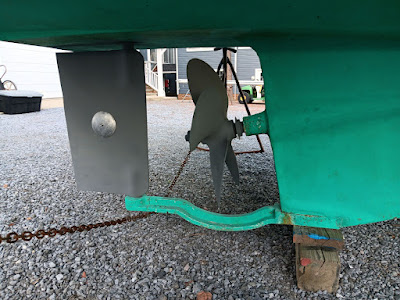 |
| A single-engine powerboat with a long keel that extends below the bottom of the prop and rudder. A strut supports the rudder and protects the prop. This is a strong design. |
 |
| Another single engine powerboat with prop and rudder well protected by a keel and strut. This is a classic wooden boat, but there are many modern boats with similar designs. There's a good reason this design has been around for so long. |
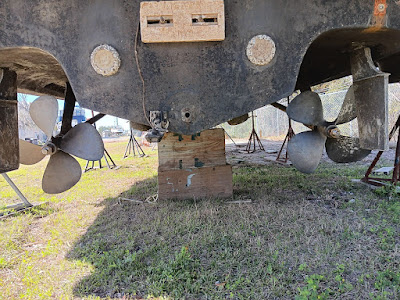 |
| A twin-engine powerboat without an actual keel. Although the props are recessed in tunnels, they still extend below the bottom of the hull, as do the unsupported rudders. |
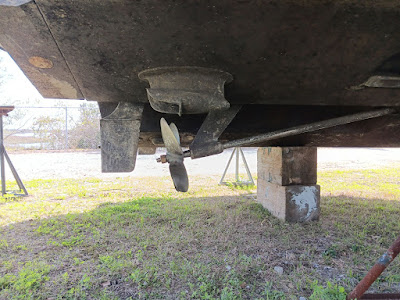 |
| Same boat as the one shown above. Here you can see that the props extend below the hull by a distance of more than half of the prop’s diameter. Even a “soft” grounding in this boat would pose a significant risk of damaging props, shafts, struts, and rudders. This design is better suited for use in open water. |
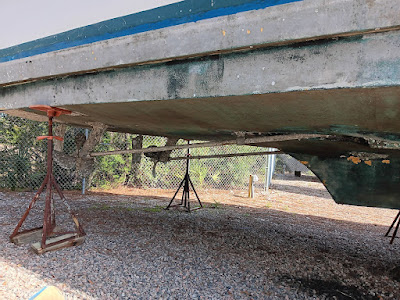 |
This twin-engine powerboat has an actual keel that is deeper than the props. There is a lot of shaft exposed, but the keel may stop the boat before the props make contact with the bottom.
|
For sailboats, spade rudders are the most vulnerable to damage during grounding. Dual spade rudders make it more difficult to extricate yourself because they prevent you from heeling the boat over. The strongest rudder design is one that is mounted on a full skeg or attached to the keel and has a gudgeon or shoe on the bottom of the rudder post. Saildrives are also very vulnerable during a grounding, unless the keel and rudder are substantially deeper than the drive. On many catamarans, the saildrives are nearly as deep as, and far behind, the keels, making them vulnerable.
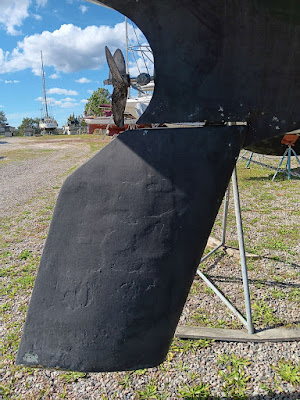 |
| An unsupported spade rudder on a monohull sailboat. This rudder post is vulnerable to impact damage during a grounding, since it is the only thing holding the rudder onto the boat. The prop on this boat is reasonably protected, given its unusual position. |
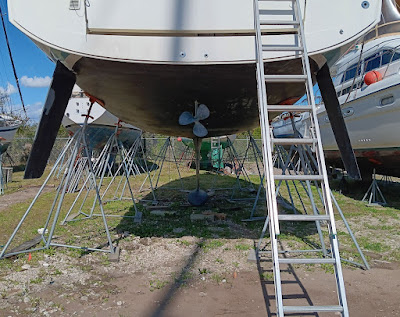 |
| Twin spade rudders (unsupported). Not only are these rudders relatively vulnerable, the twin-rudder configuration would make it difficult to refloat the boat without causing further damage. The usual strategy for refloating a grounded sailboat is to heel it over. The degree of heeling would be limited by the rudders, which would be vulnerable to damage if the boat was heeled over. |
 |
| A spade rudder supported by a full-length skeg. This design is stronger than an unsupported spade rudder, since it has two gudgeons supporting the rudder post. |
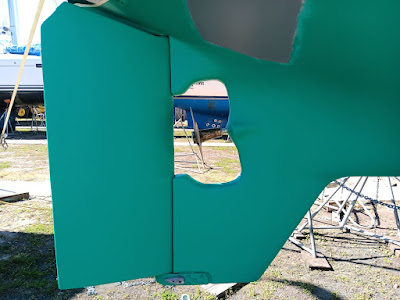 |
| A monohull sailboat rudder and prop protected by a large, full-length skeg. The rudder is supported by a gudgeon and rudder shoe and the prop is enclosed in an aperture. |
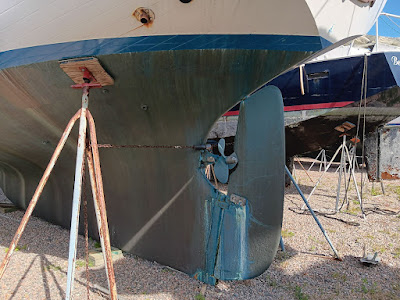 |
A full keel with attached rudder and a well-protected prop in an aperture. This boat could run hard aground without the rudder ever touching bottom. That inspires confidence.
|
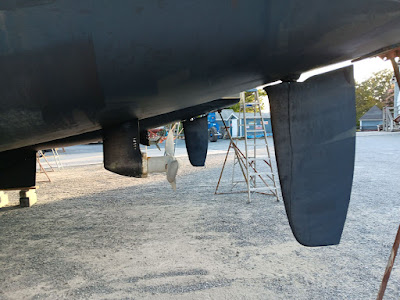 |
| A catamaran with unsupported spade rudders and saildrives. You can see that the rudders are almost as deep as the keels. On some catamarans, the spade rudders are the deepest part of the boat. |
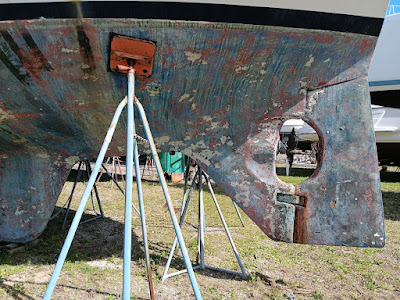 |
| A fin keel with a large skeg supporting the rudder and protecting the prop in an aperture. |
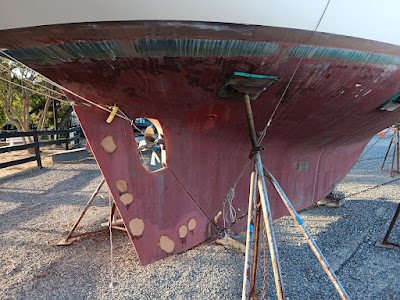 |
A full-keel boat with attached rudder and prop in an aperture.
|
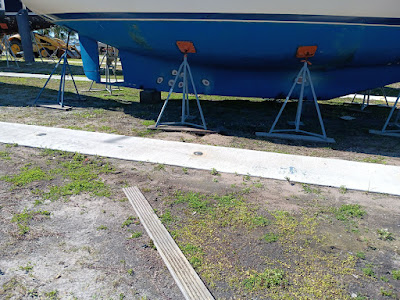 |
| A full keel with separate rudder supported by a strut. |
A lot of sailboat designs are available with either a standard or a shoal draft keel. The shoal draft keel, of course, is shorter to reduce the boat’s draft. The thing to remember is that the rudder design is usually the same in both versions. In a grounding, the rudder is much more vulnerable to damage than is the keel. This means that with the standard design, the keel is much deeper than the rudder, and therefore, provides protection. In the shoal draft version, the keel and rudder are close to the same depth, making it more likely that the rudder will come into contact with the bottom during a grounding. Some shoal draft keel designs maintain similar righting characteristics compared to the standard design by employing wings on the bottom of the keel. Wings like to fly but they don’t like to land on the mud.
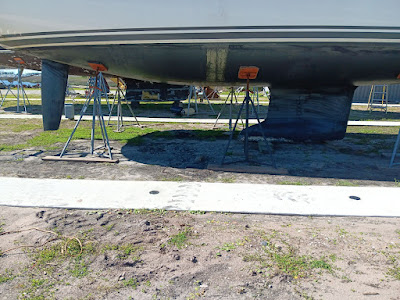 |
This rudder is nearly as deep as the keel, which has a bulb.
|
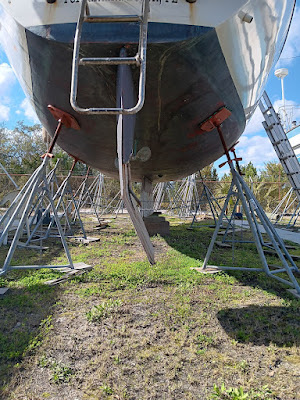 |
| This is a shoal draft fin keel with an unsupported spade rudder that is the same depth as that of the keel. Apparently, this rudder was seriously damaged during a grounding. |
For monohull sailboats, once you are aground, you’ll want to heel the boat over to get it to float free. You can’t do this if your keel has wings. Those wings are vulnerable to damage during grounding, prevent a grounded boat from heeling, and, even if you could heel the boat, the wings make the boat’s draft remain the same when it is heeled.
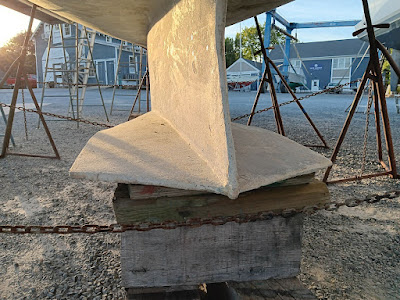 |
| This fin keel has a very large wing. The wing allows a shallower draft but is vulnerable to damage during a grounding. Once grounded, it will dig into the bottom sediments like an anchor, making it difficult to get free. It also negates any benefit from heeling the boat. As the boat heels, the wing will become more vertical, maintaining pretty much the same draft regardless of heel angle. |
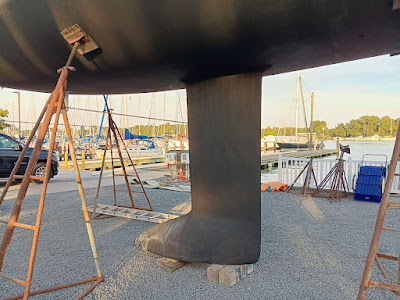 |
A high aspect ratio keel (deep but with a short fore-aft length) with a bulb.
|
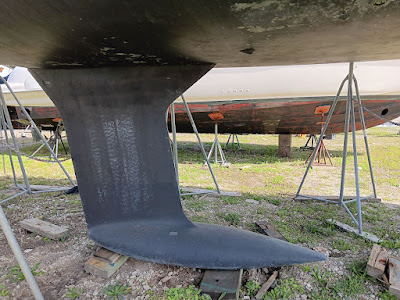 |
| Another high aspect ratio keel with a large bulb. Concentrating the weight at the bottom of the keel allows it to have a shallower draft than would be necessary with a standard fin keel. The high righting moment of this design is great for efficient sailing but would make it difficult to heel when grounded and the bulb would dig into the sediment, making it hard to back off of the shoal. This would be a great design for ocean sailing, not as much for cruising in shallows like the ICW, Bahamas, or Florida Keys. |
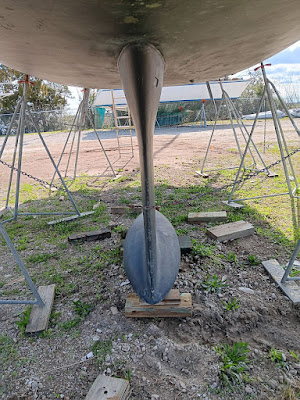 |
| Same keel as in the above photo, seen from the forward end. |
As discussed in Chapter 5, vertical clearances at fixed bridges are frequently less than the advertised height of 65 feet. And these clearances are slowly shrinking over time. In the 1970s and 1980s, sailboat manufacturers started designing sailboats specifically for use on the ICW. With standardized bridge clearances of 65 feet, the yacht designers and builders made a lot of boats with mast heights of around 64’. Forty or more years later, the clearances under these bridges are no longer 65 feet at MHHW. So the idea of an “ICW-max” mast height of 64-½ feet is no longer valid. Can you navigate the ICW with a 64’ mast? Yes, absolutely. But you will spend a lot of time waiting at bridges for the proper tide and wind conditions. You will also experience a lot of stress at every bridge. And you may be tempted to press your luck a little too much and take risks that you shouldn’t. This doesn’t sound like a lot of fun. Having fun, after all, is supposed to be the point of all of this.
Lately, we’ve heard some boat owners talking nonchalantly about their masthead VHF antennas touching the undersides of bridges. This is way too close for our comfort and would convince us to go offshore. The top of the mast is not designed to absorb any sort of impact and it can take surprisingly little force to bring down the entire rig. (Catamaran rigs tend to be more robust than those on monohulls in this regard. But we still don’t recommend it!) And most catamarans over 40’ in length have an air draft greater than 65 feet.
If we were in the market for another sailboat to cruise on the ICW, we would get one that had an air draft (including instruments) no higher than 62 feet. If you already own a boat that has a tall rig, you can have a couple of feet cut off of the mast. This sounds simple enough but it will also require replacing the standing rigging, modifying the boom attachment, and cutting a couple of feet off the bottoms of all your sails. The best time to make such a modification would be when you are planning to replace your standing rigging and/or sails. That’s just our opinion; do with it as you wish.
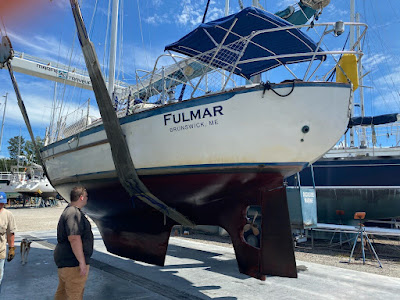 |
Fulmar, our 1982 Pacific Seacraft 37. It draws nearly 6 feet (after 42 years of cruising, it probably draws an honest 6 feet at this point). The long fin keel with large full skeg provides support for the rudder and an aperture for the prop. The bottom of the skeg has a substantial shoe. Grounding in the ICW has never been a particular concern with this configuration.
|
Notice that we haven’t said anything about draft. Our current boat draws 6 feet. People often ask if having such a deep draft makes us nervous on the ICW. Absolutely not. Our keel is strong and it’s substantially deeper than the rudder. Also, our prop is enclosed in an aperture, and the rudder is mounted on a sturdy, full-length skeg with a gudgeon at the bottom. In this boat, we have made the roundtrip run of the AICW between Chesapeake Bay and Ft. Pierce, FL, without running aground (we did bounce off of a log when we moved outside the channel to pass a tug and barge…our fault). We’ve had no serious issues whatsoever. Of course we do our homework to anticipate the shallow spots and proceed slowly and cautiously through these areas (and yes, we use Bob423’s tracks, coupled with the US Army Corps Engineers’ depth survey data as a guide in these areas). Because the boat is designed to survive groundings unscathed, we feel confident going into places with “skinny” water, places we wouldn’t dare go in a boat with a shallower draft but a less rugged design. And remember this: there are cruise ships and barges with drafts up to 10 feet that regularly navigate the ICW. If they can do it, so can you.
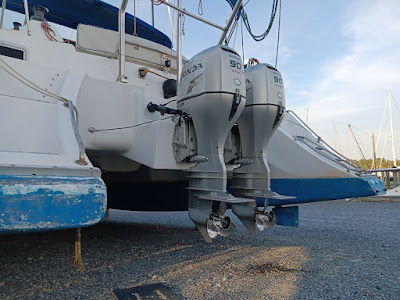 |
| Sometimes it helps to think outside the box. This is a sailing catamaran that has been highly modified. The sailing rig and diesel engines have been removed. The bridge deck was reinforced to support two outboard motors and the rudders have been shortened substantially. The smaller rudders should be stronger, with less lateral stress exerted on them during a grounding. This is a shallow draft boat that should sit quite happily on the bottom. |
Conclusion
There's no such thing as the perfect boat. The design of any boat involves a series of tradeoffs. Different people will place different values on certain design features. But if the intended purpose of the boat is to cruise the ICW there are two overriding design considerations: 1) whether the underbody is sufficiently rugged to survive a grounding and facilitate refloating, and 2) (for sailboats) whether the air draft is 63 feet or less, recognizing the reality that there are many bridges where the clearance at MHHW is no longer 65 feet.
To Learn More

